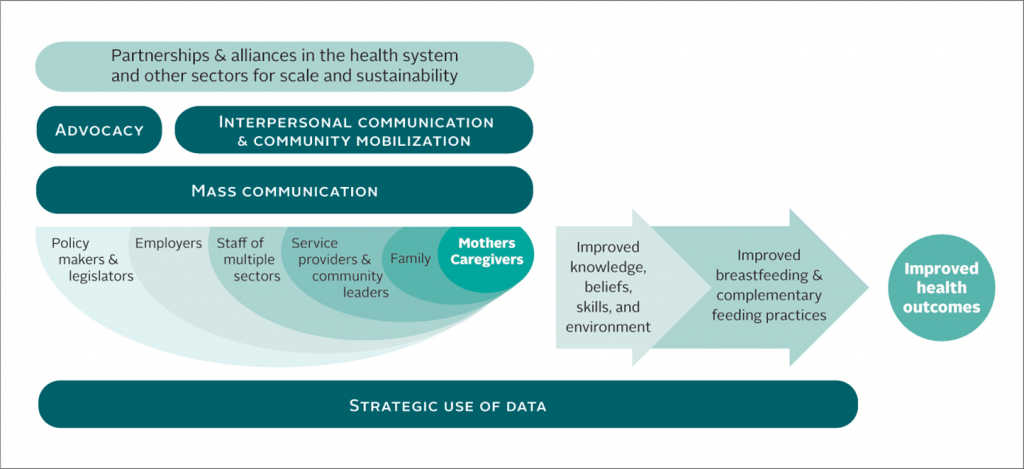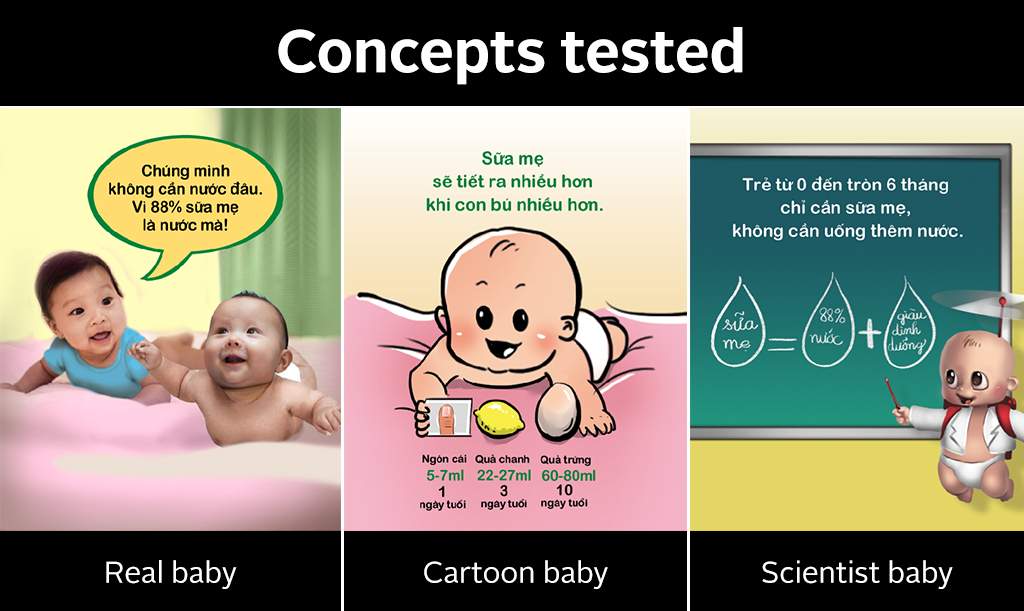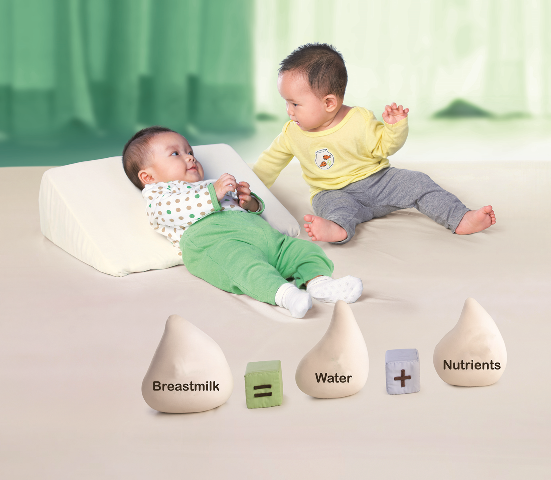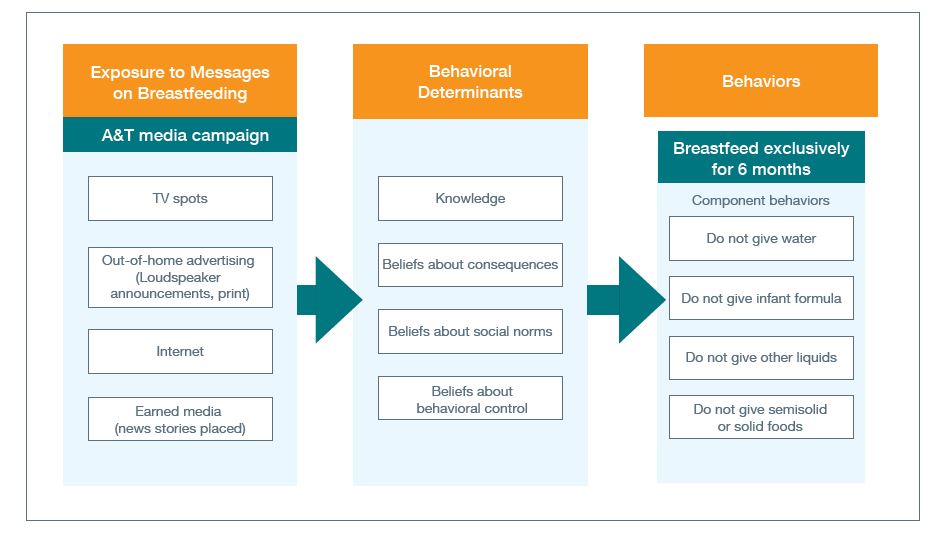The Alive & Thrive (A&T) Talking Babies Media Campaign, which ran in Viet Nam from 2011-2014, was designed to encourage mothers to practice exclusive breastfeeding (EBF). The campaign employed innovative TV spots featuring “talking babies” who encouraged their moms to feed them only breastmilk for the first six months of their lives.
Research studies conducted in 2009 had concluded that only about 20% of Vietnamese mothers practiced the ideal behavior—giving breastmilk and only breastmilk for the first six months. As a result, A&T embarked on a program to improve EBF practices in Viet Nam—through advocacy, interpersonal communication, and community mobilization—at a scale large enough to have an impact on national rates. In a little over three years, the prevalence of exclusive breastfeeding nearly tripled in areas where the program initiated high quality interpersonal counseling and support for breastfeeding provided through a franchise and support group model. When mass media was added to the mix, exclusive breastfeeding increased from 18-28 percent during the same period.
The campaign also employed an innovative social franchise model component. The social franchise model helps to standardize counseling services for caregivers at health care facilities and to monitor quality of services. This Spotlight follows the development of the mass media activities. The social franchise model activities will be covered in a forthcoming Spotlight.
Timeline
Inquire
Through a series of consultations on the ground in Viet Nam, A&T learned about opportunities to contribute to breastfeeding efforts. The team hired Ogilvy & Mather (O&M) to conduct a media audit which contributed to an understanding of the media landscape in Viet Nam and the role of mass media in marketing feeding practices and infant formula. The audit also identified and evaluated current marketing messages, materials, and media outlets with respect to feeding practices, infant formula, and other nutrition products.
The A&T team conducted formative research using an adaptation of the ProPAN (Process for the Promotion of Child Feeding) research methodology developed by the Pan American Health Organization/WHO. The research involved:
- Observations in homes, health centers, and markets
- Semi-structured interviews of 1,620 pregnant women and mothers of infants
- 24-hour dietary recall survey of 640 children 6-23 months old
- Semi-structured interviews with 80 fathers and 88 health workers
- Sixteen focus groups with grandmothers
- Trials of improved practices (TIPs)
The pillars of the program (illustrated in the strategy diagram below) were identified at the outset—advocacy, interpersonal communication, mass communication, and strategic use of data. The formative research and other studies enabled the team to help inform these pillars and develop appropriate strategies.

From the formative data and other studies, the team was able to identify the biggest threats to EBF—the practice of giving babies water to quench their thirst or clean their mouths, and the perception (held by mothers, family members, and even doctors) that Vietnamese mothers are not able to produce enough good quality milk for their babies. Consequently mothers and caregivers alike, including health workers, had come to believe that a combination of breast milk and infant formula was the best nutrition for an infant.
These findings helped to shape the interpersonal communication activities and the mass media campaign.

Focus group
- Strategic Design of Mass Media to Promote Breastfeeding
- Formative Research on Infant and Young Child Feeding in Vietnam, Phase I
- Formative Research on Infant and Young Child Feeding in Vietnam, Phase II
Design Strategy
In 2010, A&T initiated early concept testing. A private sector cross-cultural marketing firm based in the US, interested in contributing to the campaign, offered pro bono market research designed to help A&T develop models to address the important issues in the mass media campaign.
The issues to be addressed were:
Mothers, grandmothers, and even health providers believed that Vietnamese mothers just were not capable of producing enough breastmilk to sustain their babies for the first six months
Mothers trusted in science and medical experts
Mothers believed that giving a few drops of water was not detrimental to a child’s health
Create and Test
Rounds two and three of the concept testing, as well as the pretesting of the actual materials, took place in 2011.
For round two of concept testing, A&T hired Indochina Research to test concepts in 32 focus groups in order to guide decisions about messages, characters, storylines, visuals, and formats. Results showed that participants preferred to hear scientific evidence to support any claims about breastfeeding. A&T tested the concepts with mothers of young babies, grandmothers, and health workers. Using babies as an emotional hook to promote breastmilk (concept 2) was seen by the audience as the most appealing and trustworthy.
For round three of concept testing, three visuals of different types of babies (animated and live) were shown to 36 focus groups to find out which was most appealing and whether the call-to-action was clear. Results of this round revealed that mothers, caregivers and health workers liked the concept of babies talking to their mothers about the best nutrition for them. This was exciting to the team, even though the production challenges were a bit daunting.
The concepts tested were:
Live baby “talking”
Cartoon baby “talking”
Scientist baby “talking”

During pretesting, participants were shown storyboards developed by O&M. The pretest firm tested the storyboards with mothers and grandmothers. The tests helped the team reach a decision about the storyline, language, look, and feel of the spots
It was a challenge to produce two TV spots with infants—a six month old and a four month old. In addition, the babies needed to be shown “talking” to each other. The shoot itself took two full days, with plenty of breaks in the filming for the baby “stars” to breastfeed, rest, and sleep. The team then auditioned children between three and five years of age to record the babies’ dialogue—one set of voices for the northern part of the country and one for the south, since the accents are different. Then came the difficult task of matching the words to the movement of the babies’ mouths—this was accomplished digitally. The team developed a video documenting the unique expeirence of working with the baby stars.

Screen shot of the baby stars
Mobilize and Monitor
Only the TV spots were aired throughout the entire country, whereas the full mass media campaign was implemented in 15 provinces, where interpersonal counseling on infant and young child feeding was also available, through a social franchise model at government health centers and with mothers’ support groups in remote villages.
The full mass media campaign, built around the “talking” babies of the TV spots, included audio messages delivered over outdoor loudspeakers, print ads on the outside of buses, billboards, and posters in health centers. The TV spots were displayed on LCD screens in hospitals, health centers, and supermarkets. Urban mothers benefited from online activities, including a website dedicated to infant and young child feeding, interactive online counseling, interactive mothers’ forum, TV spots placed on Vietnamese websites that are most popular with women, Facebook fan page, and a mobile app to connect young mothers and allow them to track baby’s milestones, share photos, and access information on feeding recommendations.
A&T developed a rigorous monitoring process in order to track the program’s implementation and watch for changes in knowledge, beliefs, and practices as the program was underway. The findings enabled the team to adjust the media plan in order to reach the greatest number of people.
Evaluate and Evolve
Additional funding gave A&T the chance to conduct a rigorous evaluation of the mass media campaign. They invited leaders in the field of evaluation of mass media for health, including Dr. Robert Hornik of the Annenberg School for Communication, University of Pennsylvania. Television coverage, especially coverage of national channels, is very high in Viet Nam, making a randomized control trial an unfeasible evaluation approach.
To strengthen the case that the TV spots contributed to behavior change, A&T developed a behavior change pathway and inserted a number of questions to measure possible behavioral determinants—in the categories of knowledge, beliefs about outcomes of the behavior, perceptions of social norms, and sense of self-efficacy. The hypothesis was that the mass media messages would have an impact on behavioral determinants which in turn would lead to a change in the desired behavior of exclusive breastfeeding.

Behavior Change Pathway
“We learned from our baseline survey that mothers who do not believe an infant will be thirsty are 54% more likely to exclusively breastfeed, and mothers who believe that exclusive breastfeeding is the norm are 77% more likely to breastfeed. These were the types of determinants that the campaign aimed to address.”
—Silvia Alayón, Alive & Thrive Nutrition and Monitoring Advisor, Save the Children
In July-August 2011 A&T conducted a baseline survey with over 6,000 mothers of children under six months in 11 provinces. They then conducted three rounds of data collection in a sub-set of four provinces and a final endline in 11 provinces in April-May 2014. Experience from the baseline helped the team to refine questions and identify those determinants that were likely to be most predictive of desired practice. Round 1 of data collection helped to refine the behavioral determinant questions further.
Each wave of data collection was timed to follow a burst of the TV campaign. For the final wave, the team returned to all 11 provinces in which the baseline had been conducted.
The data from the various rounds show that behavior change can happen rapidly.
Evaluation showed that:
- Just a year into the mass media campaign, EBF had risen from 22% to 58% in intensive areas and from 30% to 37% in TV-only areas.
- Women who recalled three or more messages from the mass media campaign were significantly more likely to be giving only breastmilk (the behavioral goal).
- To enable norm formation and sustain behavior change for EBF across new cohorts of babies, sustained and intensive mass media bursts must be maintained over time.
- During the life of the campaign, more mothers reported being confident that their breastmilk was enough.
“What’s important is that the spots help more mothers practice exclusive breastfeeding for the first 6 months. [Mothers] believe the message that they don’t need to give water to the baby. People are talking about breastfeeding in ways they didn’t before the campaign. And behavior is changing.”
—Nguyen Huong Giang, Alive & Thrive/Viet Nam, Behavior Change Communications Specialist
- Formative Research on Infant and Young Child Feeding in Vietnam, Phase I
- Formative Research on Infant and Young Child Feeding in Vietnam, Phase II
- Evaluating the Impact of Mass Media on Breastfeeding Practices in Viet Nam
Planning for the Future
From the outset, A&T worked closely with the Vietnamese government and local and international partners to develop and implement a comprehensive program to improve infant and young child feeding.
This steady attention to partnerships paid off. In 2014, after 5 years of implementation, A&T handed over management of the interpersonal counseling in child feeding to the Vietnamese government, which has committed to sustaining and replicating the network of social franchises and support groups.
A&T’s behavior change communication strategy has generated widespread interest in the region with the Cambodian Ministry of Health, for example, adapting A&T’s TV spots to advance its national nutrition strategy.
Lesson Learned: Mass Media Assures Scale
A&T has demonstrated that intensive, comprehensive programming—with advocacy, interpersonal communication and community mobilization, mass communication, and strategic use of data—can result in large scale behavior change. A&T’s experience in Viet Nam confirms the belief that to reach scale in a timely manner and with impact, an infant and young child feeding program must use the mass media channels available to it.
Lesson Learned: Full Use of Multimedia Makes a Difference
The TV spots reached families throughout the country—and on their own, have the potential to increase many mothers’ EBF behaviors. But the full multimedia campaign included the TV spots, posters, billboards, bus ads, and community loudspeaker announcements. This full media campaign was conducted in the same geographic areas where the interpersonal counseling program was underway. Not surprisingly, A&T saw greater behavior changes in areas with greater intensity.
Lesson Learned: Media Intensity Matters
A&T had been advised by Dr. Hornik, an expert in evaluation of mass media campaigns for health, that there was no point in evaluating a campaign unless its intensity was close to the intensity of commercial media campaigns. Negotiating discounts for the media buy, with support from the government, helped to enhance that intensity.
It is estimated that formula companies spend $13 million each year on advertising in Viet Nam. A&T spent approximately $5 million over three years. In addition to the media buys to broadcast spots on national and provincial TV stations, they placed the spots on websites that are the most popular with young urban mothers and played them on screens in supermarkets and at health centers.
The A&T team learned that the intensity of the media buy was important. As new women become pregnant and are parenting children under 6 months of age, the intended audience is always “fresh” and newly attuned to messages about breastfeeding.
Lesson Learned: Tracking Behavioral Determinants Strengthens Evaluation
The A&T team learned a lot about the behavioral determinants of EBF—and how to track them. For example, they learned from the baseline survey that the perception that EBF for six months is the norm is associated with increased exclusive breastfeeding. And they are able to state that exposure to the campaign’s TV spots increased mothers’ perception that exclusive breastfeeding is the social norm. For a number of these behavioral determinants, the evaluation plan allowed them to trace the behavioral pathway: exposure to TV spots changed the belief, and changes in that belief are associated with increased behavior.
Awards
- 2013 Creative For Good
- 2013 GBCHealth PSA
- 2014 Asia-Pacific Tambuli Award Winners for Social Good Marketing that Delivers Results
Date of Publication: April 20, 2022



